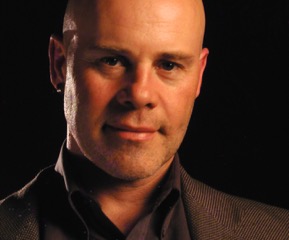
Thomas Dolby
The Taylor A. Hanex Professorship in Music for New Media
Music for New Media
Thomas Dolby will be formally installed as the inaugural recipient of the Taylor A. Hanex Professorship in Music for New Media at a later date.
The list of breakthrough innovations in Thomas Dolby’s 35-year career is continuous. As an early MTV icon he blazed a trail for electronic music with his imaginative videos. The same year as his own record reached the top of the pop/dance charts, he co-wrote and produced the first ever platinum-selling rap 12” single “Magic’s Wand” by Whodini. His synth playing and production have graced the recordings of Foreigner, Def Leppard, George Clinton and Joni Mitchell, earning five Grammy nominations. He appeared live with Stevie Wonder and Herbie Hancock, with David Bowie at Live Aid, and with Roger Waters at The Wall in Berlin. And his self-penned “She Blinded Me With Science” became a Top 5 Billboard hit, going on to become an evergreen geek anthem of the 1980s that still pops up in Grand Theft Auto, The Big Bang Theory and Breaking Bad.
Thomas Dolby has created original music for feature films produced by George Lucas, Steven Spielberg and Ken Russell; he has appeared with The Muppets, and on numerous TV shows from Soul Train to The Late Show.
Sought after as a consultant for tech startups and research companies, Dolby seemed to have a hand in every emerging entertainment platform, from laser disks and computer games to interactive TV, virtual reality installations and location-based entertainment. His name is on multiple US patents, and he has worked as an investment advisor for top venture capital firms. During the early Silicon Valley internet explosion, Thomas Dolby founded high tech startup Beatnik Inc and co-created the code that drove interactive audio in Java. When mobile phones began to play polyphonic ringtones, it was via his BAE technology, which Beatnik licensed to phone manufacturers to be embedded in over two billion cellular phones and devices.
Thomas Dolby has created music and soundtracks for computer games including Siberia (PC), Grand Theft Auto (Playstation), Double Switch (Sega), Obsidian (MacOS), Toadlickers (iOS), and The Dark Eye (CD-ROM). He created the first ever music-oriented Virtual Reality installation, The Virtual String Quartet, at the Guggenheim Museum in New York in 1993. He was co-author of the Audio Virtual Reality Engine (AVRe) software for game sound, the Beatnik Audio Engine for Web and mobile devices and set-top boxes, and the industry-standard file types Rich Music Format (RMF) and Mobile MIDI. He is the holder of multiple patents in the field of interactive audio.
Between adding music to the mix as in-house Music Director of every TED Conference from 2001 to 2012, Dolby taught himself to be a digital filmmaker. In 2013 he won multiple awards for his groundbreaking film The Invisible Lighthouse, which chronicles the closure of a 250-year-old lighthouse visible from his coastal home in Suffolk, UK.
In fall 2014, Thomas Dolby was named Homewood Professor of the Arts at Johns Hopkins University. He is currently the head of the Peabody Conservatory’s Music for New Media program, which launched in the fall semester of 2018. He has recently released his first book, The Speed Of Sound, on Macmillan/Flatiron.